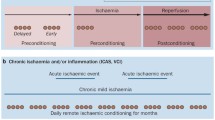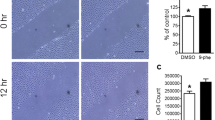Abstract
Remote ischemic conditioning (RIC) is a powerful cardioprotectant and neuroprotectant. The mechanism of protection likely involves circulating, blood-borne mediators that transmit the signal from the periphery to the brain. The neuroprotective effect of RIC may be partially related to improvements in cerebral blood flow (CBF). Nitrite is a key circulating mediator of RIC and may be a mediator of increased CBF and also mediate cytoprotection through its effects on nitrosylation of mitochondrial proteins such as complex I. Measuring plasma nitrite may serve as an important blood biomarker, and measuring CBF by techniques such as MRI arterial spin labeling (ASL) may be an ideal surrogate imaging biomarker in clinical trials of RIC.
Access this chapter
Tax calculation will be finalised at checkout
Purchases are for personal use only
Similar content being viewed by others
References
Murry CE, Jennings RB, Reimer KA (1986) Preconditioning with ischemia: a delay of lethal cell injury in ischemic myocardium. Circulation 74(5):1124–1136
Przyklenk K, Bauer B, Ovize M, Kloner RA, Whittaker P (1993) Regional ischemic ‘preconditioning’ protects remote virgin myocardium from subsequent sustained coronary occlusion. Circulation 87(3):893–899
Gho BC, Schoemaker RG, van den Doel MA, Duncker DJ, Verdouw PD (1996) Myocardial protection by brief ischemia in noncardiac tissue. Circulation 94(9):2193–2200
Birnbaum Y, Hale SL, Kloner RA (1997) Ischemic preconditioning at a distance: reduction of myocardial infarct size by partial reduction of blood supply combined with rapid stimulation of the gastrocnemius muscle in the rabbit. Circulation 96(5):1641–1646
Schmidt MR, Smerup M, Konstantinov IE, Shimizu M, Li J, Cheung M et al (2007) Intermittent peripheral tissue ischemia during coronary ischemia reduces myocardial infarction through a KATP-dependent mechanism: first demonstration of remote ischemic perconditioning. Am J Physiol Heart Circ Physiol 292(4):H1883–H1890
Malhotra S, Naggar I, Stewart M, Rosenbaum DM (2011) Neurogenic pathway mediated remote preconditioning protects the brain from transient focal ischemic injury. Brain Res 1386:184–190
Shimizu M, Tropak M, Diaz RJ, Suto F, Surendra H, Kuzmin E et al (2009) Transient limb ischaemia remotely preconditions through a humoral mechanism acting directly on the myocardium: evidence suggesting cross-species protection. Clin Sci (Lond) 117(5):191–200
Konstantinov IE, Li J, Cheung MM, Shimizu M, Stokoe J, Kharbanda RK et al (2005) Remote ischemic preconditioning of the recipient reduces myocardial ischemia-reperfusion injury of the denervated donor heart via a Katp channel-dependent mechanism. Transplantation 79(12):1691–1695
Davidson SM, Selvaraj P, He D, Boi-Doku C, Yellon RL, Vicencio JM et al (2013) Remote ischaemic preconditioning involves signalling through the SDF-1alpha/CXCR4 signalling axis. Basic Res Cardiol 108(5):377
Cai ZP, Parajuli N, Zheng X, Becker L (2012) Remote ischemic preconditioning confers late protection against myocardial ischemia-reperfusion injury in mice by upregulating interleukin-10. Basic Res Cardiol 107(4):277
Li J, Rohailla S, Gelber N, Rutka J, Sabah N, Gladstone RA et al (2014) MicroRNA-144 is a circulating effector of remote ischemic preconditioning. Basic Res Cardiol 109(5):423
Rassaf T, Totzeck M, Hendgen-Cotta UB, Shiva S, Heusch G, Kelm M (2014) Circulating nitrite contributes to cardioprotection by remote ischemic preconditioning. Circ Res 114(10):1601–1610
Shimizu M, Konstantinov IE, Kharbanda RK, Cheung MH, Redington AN (2007) Effects of intermittent lower limb ischaemia on coronary blood flow and coronary resistance in pigs. Acta Physiol (Oxf) 190(2):103–109
Kono Y, Fukuda S, Hanatani A, Nakanishi K, Otsuka K, Taguchi H et al (2014) Remote ischemic conditioning improves coronary microcirculation in healthy subjects and patients with heart failure. Drug Des Devel Ther 8:1175–1181
Dawson DA, Furuya K, Gotoh J, Nakao Y, Hallenbeck JM (1999) Cerebrovascular hemodynamics and ischemic tolerance: lipopolysaccharide-induced resistance to focal cerebral ischemia is not due to changes in severity of the initial ischemic insult, but is associated with preservation of microvascular perfusion. J Cereb Blood Flow Metab 19(6):616–623
Zhao L, Nowak TS Jr (2006) CBF changes associated with focal ischemic preconditioning in the spontaneously hypertensive rat. J Cereb Blood Flow Metab 26(9):1128–1140
Hoyte LC, Papadakis M, Barber PA, Buchan AM (2006) Improved regional cerebral blood flow is important for the protection seen in a mouse model of late phase ischemic preconditioning. Brain Res 1121(1):231–237
Hoda MN, Bhatia K, Hafez SS, Johnson MH, Siddiqui S, Ergul A et al (2014) Remote ischemic perconditioning is effective after embolic stroke in ovariectomized female mice. Transl Stroke Res 5:484–490
Hoda MN, Fagan SC, Khan MB, Vaibhav K, Chaudhary A, Wang P et al (2014) A 2 x 2 factorial design for the combination therapy of minocycline and remote ischemic perconditioning: efficacy in a preclinical trial in murine thromboembolic stroke model. Exp Transl Stroke Med 6:10
Hoda MN, Siddiqui S, Herberg S, Periyasamy-Thandavan S, Bhatia K, Hafez SS et al (2012) Remote ischemic perconditioning is effective alone and in combination with intravenous tissue-type plasminogen activator in murine model of embolic stroke. Stroke 43(10):2794–2799
Khan MB, Hoda MN, Vaibhav K, Giri S, Wang P, Waller JL et al (2015) Remote ischemic postconditioning: harnessing endogenous protection in a murine model of vascular cognitive impairment. Transl Stroke Res 6(1):69–77
Gidday JM, Shah AR, Maceren RG, Wang Q, Pelligrino DA, Holtzman DM et al (1999) Nitric oxide mediates cerebral ischemic tolerance in a neonatal rat model of hypoxic preconditioning. J Cereb Blood Flow Metab 19(3):331–340
Atochin DN, Clark J, Demchenko IT, Moskowitz MA, Huang PL (2003) Rapid cerebral ischemic preconditioning in mice deficient in endothelial and neuronal nitric oxide synthases. Stroke 34(5):1299–1303
Orio M, Kunz A, Kawano T, Anrather J, Zhou P, Iadecola C (2007) Lipopolysaccharide induces early tolerance to excitotoxicity via nitric oxide and cGMP. Stroke 38(10):2812–2817
Abu-Amara M, Yang SY, Quaglia A, Rowley P, de Mel A, Tapuria N et al (2011) Nitric oxide is an essential mediator of the protective effects of remote ischaemic preconditioning in a mouse model of liver ischaemia/reperfusion injury. Clin Sci (Lond) 121(6):257–266
Abu-Amara M, Yang SY, Quaglia A, Rowley P, Fuller B, Seifalian A et al (2011) Role of endothelial nitric oxide synthase in remote ischemic preconditioning of the mouse liver. Liver Transpl 17(5):610–619
Ovize M, Baxter GF, Di Lisa F, Ferdinandy P, Garcia-Dorado D, Hausenloy DJ et al (2010) Postconditioning and protection from reperfusion injury: where do we stand? Position paper from the Working Group of Cellular Biology of the Heart of the European Society of Cardiology. Cardiovasc Res 87(3):406–423
Kim-Shapiro DB, Gladwin MT (2014) Mechanisms of nitrite bioactivation. Nitric Oxide 38:58–68
Liu C, Wajih N, Liu X, Basu S, Janes J, Marvel M et al (2015) Mechanisms of human erythrocytic bioactivation of nitrite. J Biol Chem 290(2):1281–1294
Acknowledgments
The authors would like to acknowledge Colby Polonsky, medical illustrator, Georgia Regent’s University for Fig. 1. This work is supported by NIH-NINDS R21 NS081143.
Conflict of Interest
The authors have no conflicts of interest to report.
Author information
Authors and Affiliations
Corresponding author
Editor information
Editors and Affiliations
Rights and permissions
Copyright information
© 2016 Springer International Publishing Switzerland
About this chapter
Cite this chapter
Hess, D.C., Hoda, M.N., Khan, M.B. (2016). Humoral Mediators of Remote Ischemic Conditioning: Important Role of eNOS/NO/Nitrite. In: Applegate, R., Chen, G., Feng, H., Zhang, J. (eds) Brain Edema XVI. Acta Neurochirurgica Supplement, vol 121. Springer, Cham. https://doi.org/10.1007/978-3-319-18497-5_8
Download citation
DOI: https://doi.org/10.1007/978-3-319-18497-5_8
Publisher Name: Springer, Cham
Print ISBN: 978-3-319-18496-8
Online ISBN: 978-3-319-18497-5
eBook Packages: MedicineMedicine (R0)




